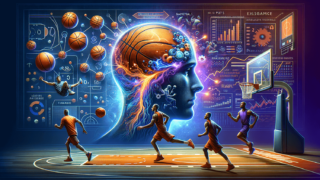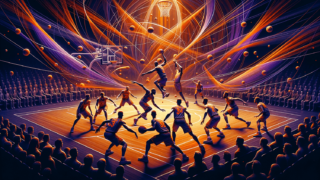
Role of Conditioning and Recovery in Basketball Performance
Written by: Basketball Universe
Last updated:

As the shimmering squeak of sneakers on hardwood floors echoes through the gym, we’re often reminded that basketball isn’t just a game of skill and strategy, but also one of endurance and resilience. Welcome aboard, hoop fanatics, to our in-depth exploration of the crucial role of conditioning and recovery in basketball performance! In this post, we’ll delve into the nitty-gritty of optimizing players’ physical capabilities, dissecting the importance of strength, flexibility, and proper recovery routines – all while maintaining a fun, professional vibe. So lace up your high-tops, grab your water bottle, and gear up for a slam dunk of valuable knowledge!
Role of Conditioning and Recovery in Basketball Performance
Conditioning and recovery play a pivotal role in a basketball player’s performance. They help to enhance physical skills like strength, speed, and agility, as well as reduce the risk of injury. Conditioning encompasses strength training, aerobic exercises, and flexibility routines that improve a player’s endurance and power, while recovery focuses on rest, nutrition, and therapeutic techniques to rehabilitate muscles and prevent overtraining. Together, these factors contribute to a well-rounded athlete, ready to face the high demands of this fast-paced sport.
Unlocking Athletic Potential with Conditioning
Conditioning is the cornerstone of a basketball player’s physical prowess, enabling them to unleash their hidden potential and take their game to new heights. Let’s discover the components of an effective conditioning program that’ll make you rule the court!
Aerobic & Anaerobic Conditioning: Two Sides of the Same Coin
Aerobic conditioning is all about improving your cardiovascular fitness, which translates to better endurance and reduced fatigue on the court. Some popular aerobic exercises include running, swimming, cycling, and skipping rope. These workouts ensure that you have the stamina to keep up with the game’s fast-paced nature, allowing you to go strong till the final buzzer!
But let’s not forget anaerobic conditioning, which trains your body to work efficiently without sufficient oxygen. This type of conditioning is crucial for short, intense bursts of energy, perfect for those explosive jumps and quick sprints. Plyometrics, interval training, sprints, and resistance bands encompass highly effective anaerobic workouts that’ll have you sprinting past your opponents effortlessly.
Strength Training: Building Muscles for a Strong Game
Strength training is a game-changer in basketball, empowering athletes to battle through intense physical challenges. By incorporating targeted exercises in your routine, you can increase your muscular strength and power, improving your overall performance. Here are some exercises highly recommended by basketball aficionados:
- Squats and lunges: Great for strengthening your lower body muscles, which are essential for jumping and sprinting.
- Push-ups, pull-ups, and dips: These compound exercises target multiple muscle groups, including the chest, back, shoulders, and arms, essential for holding your ground in the post, shot blocking, and shooting accuracy.
- Core exercises: Planks, leg raises, Russian twists, and medicine ball exercises enhance your torso’s stability, which is integral for maintaining balance and generating power during dynamic movements.
Flexibility Training: The Unsung Hero of Basketball Conditioning
Often overlooked, flexibility training is vital for superior court performance. By incorporating stretching routines into your workouts, you’ll improve your joint mobility, range of motion, and injury prevention. Both static and dynamic stretches have their place in a basketball player’s repertoire. Static stretches involve holding a position for 15-30 seconds, while dynamic stretches require movement through a specific range of motion, ideal as a pre-game warm-up.
Revitalizing the Body: The Importance of Recovery
Recovery is just as crucial as conditioning in basketball performance. It helps the body bounce back after tough workouts, makes the most of the gains you’ve achieved through training, and keeps aches and injuries at bay. Let’s dive into the best recovery practices for a holistic approach to your basketball performance!
Rest: The Cornerstone of Recovery
Getting ample rest should be a priority on every player’s agenda, as it promotes muscle repair, decreased inflammation, and improved immunity. Remember that recovery time varies based on factors like age, training intensity, and basketball history (the athlete’s experience, not the sport’s fascinating past!). So, listen to your body’s cues and ensure that you provide it with adequate downtime.
Nutrition: Fueling the Body for Peak Performance
What you put into your body greatly impacts your recovery process. Proper nutrition is non-negotiable for a well-rounded athlete. Following a balanced diet that meets your daily caloric needs ensures you’re ready to tackle the challenges on the court. Key focus points for your nutrition include:
- Carbohydrates: Loading up on complex carbs like whole grains, fruits, and vegetables provides the energy needed to fuel your workouts and replenish your glycogen stores after training.
- Proteins: Consuming adequate proteins like fish, lean meats, eggs, and legumes supports muscle building and repair, speeding up recovery.
- Fats: Healthy fats like avocados, nuts, and olive oil contribute to cell function, hormone production, and inflammation reduction.
- Hydration: Staying hydrated is paramount for optimal athletic performance. Prioritize water, and consider sports drinks containing electrolytes to replace those lost during intense training sessions.
Therapeutic Tools & Techniques that Expedite Recovery
Today’s basketball world has no shortage of innovative recovery tools and techniques designed to keep players in top condition. Incorporating these methods into your routine can greatly aid your rehabilitation process, keeping you fresh and ready for the next game:
- Foam rolling: This self-myofascial release technique improves flexibility and blood circulation while reducing muscle tightness and soreness.
- Compression garments: Wearing compression socks, sleeves, or leggings can help reduce muscle fatigue, soreness, and inflammation.
- Ice & heat therapy: Alternating between ice packs and heat pads can effectively reduce inflammation, alleviate pain, and enhance blood flow to the affected area.
- Massage: Regular massages can help relieve muscle tension, promote relaxation, and stimulate the healing process.
- Sleep: Prioritizing sleep is vital in every athlete’s schedule. Aim for 7-9 hours of quality sleep each night to improve your physical recovery, mental clarity, and overall performance.
Achieving Symbiosis: Balancing Conditioning and Recovery
While conditioning and recovery may seem like two distinct elements of basketball performance, they’re inherently interconnected. A fine balance between the two is necessary for a holistic approach to your success on the court. By understanding and implementing both components, players can expect amazing results: increased stamina, reduced injury risk, and superior performance. So, get ready to crush your basketball goals, one conditioning and recovery session at a time!
Adapting to Your Body’s Unique Needs
Each basketball player has their unique strengths and weaknesses, which makes adapting your conditioning and recovery regimen paramount to your growth. It is crucial to listen to your body and make necessary adjustments to create a tailor-made program that enhances your performance. Let’s explore some factors to consider when customizing your approach:
Assess Your Skills and Gaps
Take a step back and assess your current playing abilities. Identify your strengths and hone your skills further, and recognize areas where you may fall short. Focusing on filling those gaps should be an integral part of designing your conditioning and recovery program.
Create A Personalized Plan
Once you have a solid understanding of your abilities, work with a coach or trainer to help craft a customized training plan that addresses your specific needs. Remember to include different components: aerobic and anaerobic conditioning, strength training, flexibility exercises, and recovery interventions. The key is to strike the perfect balance for you.
Monitor Progress and Adapt
Improvement is never linear; it takes time, effort, and patience. Regularly assess your progress and make modifications as needed to keep your conditioning and recovery in sync with your evolving needs. Don’t get disheartened by setbacks but instead, use them as opportunities to learn and grow.
Delving Deeper: The Mind-Body Connection
In addition to physical conditioning and recovery, mental fitness is a vital aspect of a basketball player’s repertoire. Strengthen your mind to synchronize your physical efforts with your mental resilience – a powerful combination for unbeatable performance.
Mental Training Techniques
Integrating mental training into your basketball practice enhances focus, composure, and confidence. These techniques can help you effortlessly gain control over your mind:
- Goal setting: Establish clear, measurable, and attainable short-term and long-term goals to keep yourself motivated.
- Visualization: Use your mind’s eye to create vivid images of yourself achieving successful plays and overcoming obstacles during games.
- Positive self-talk: Reframe any negative thoughts with affirmative, constructive statements to redirect your focus onto your abilities and growth.
- Mindfulness practices: Incorporate meditation or deep breathing exercises into your daily routine to increase self-awareness and stress management.
Building Emotional Resilience
Emotional resilience equips you to bounce back from disappointment and adversity, allowing you to conquer every challenge on the court. Cultivate a growth mindset to embrace setbacks as learning opportunities, building a strong support system to share your experiences, and developing assertive communication to express yourself effectively.
By creating a symbiotic relationship between your body and mind, you’ll be set on a path toward unparalleled basketball performance, possessing the power to conquer every challenge on and off the court!
FAQs About Conditioning and Recovery in Basketball Performance
In this frequently asked questions (FAQ) section, we will answer some common queries related to conditioning and recovery in basketball performance, helping simplify the process and providing actionable advice for players looking to improve their game.
1. What is the ideal number of conditioning sessions per week for a basketball player?
Depending on your skill level and training goals, aim for at least 3 to 5 conditioning sessions per week, evenly distributed to avoid overloading your muscles. Remember that these training sessions should cover various components like aerobic, anaerobic, strength, and flexibility.
2. How many rest days should a basketball player have each week?
Most players should aim for 1 or 2 rest days per week, allowing the body to recover and repair itself. Note that this largely depends on factors like age, fitness levels, and overall training intensity. Listen to your body’s cues and adjust accordingly.
3. Can I skip the flexibility exercises if I already have good flexibility?
Even if you’re blessed with good flexibility, including regular flexibility exercises in your routine is still essential to maintain your range of motion, reduce injury risk, and enhance your overall performance.
4. How long should a foam rolling session last?
For optimal results, aim for a foam rolling session of 10-20 minutes, targeting large muscle groups (like glutes, hamstrings, quads, and calves) and spending about 30 seconds to 1 minute on each area. Remember to go slow and steady, focusing on your breath throughout the session.
5. How soon after a game or practice should I consume a recovery meal?
It’s ideal to consume a recovery meal within the first 30-60 minutes post-exercise when the body is most receptive to nutrient absorption. Aim for a meal with a 3:1 or 4:1 carbohydrate-to-protein ratio, which helps replenish glycogen stores and repair muscle tissues.
6. Should I use both heat and ice therapy or just one of them?
Both heat and ice therapy can aid in muscle recovery, but they serve different purposes. Ice therapy is best for reducing inflammation and numbing pain immediately after an injury, whereas heat therapy helps to relax tight muscles, increase circulation, and promote healing. It’s essential to understand when to use each modality correctly for optimal results.
7. What kind of stretches should I do before a game?
Before a game or practice, focus on dynamic stretches that involve movement through a specific range of motion. These stretches activate the muscles, warm up the body, and improve agility, making you better prepared for the game. Examples include forward and lateral leg swings, high knees, and arm circles.
8. How do I know if I am overtraining?
Overtraining occurs when you’re not allowing your body enough time to recover between sessions. Symptoms include persistent fatigue, decreased performance, increased injury risk, sleep disturbances, mood changes, and a weakened immune system. If you suspect overtraining, consider reducing your training intensity or frequency and ensuring proper recovery techniques are in place.
9. How can I monitor my progress in terms of conditioning and recovery?
Track your progress by maintaining a training log that records your workout details, performance metrics, and how you felt during and after each session. Additionally, keep an eye on your game performance, noting improvements in endurance, strength, flexibility, and overall skill. Adjust your conditioning and recovery regimen as needed based on your progress and goals.
10. Are there any essential supplements basketball players should consider?
While whole-food sources should be your primary focus, there are some supplements that can help basketball players enhance performance and recovery. For example, consider protein powder for muscle repair and growth, creatine for enhanced work capacity, and branched-chain amino acids (BCAAs) for decreased muscle soreness. Always consult with a healthcare professional before starting any supplement regimen.
Featured Posts
- No pillar pages found.




